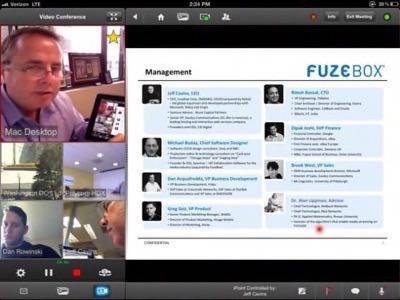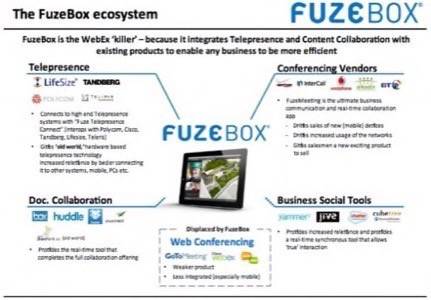Unified communications is one of those terms that makes enterprise IT guys giddy but also haunts their dreams. The idea of unified communications was conceived in the late 1970s and early ’80s when the first Public Branch Exchange systems (PBX) were put in place. The concept continued to evolve with the advent of IP-based communications, but the true dream of UC – a simple, always-available telelphony system that tied into all other forms of communication – remained elusive. While many vendors think they have figured out the UC conundrum, each is always missing the key ingredient: simple.

That is starting to change. Mobile technology and the cloud give developers the capability to bring true unified communications closer to reality than ever before. Leading the charge is the iPad, a simple device that makes complex tasks easy. FuzeBox, working with Apple from its Cupertino campus, brings us closer to real UC with the release of an application today for the new iPad. While FuzeBox takes an incremental step, it does not reach UC. Will we ever fulfill the dream for simple and ubiquitous unified communications?

The Tangled UC Web
Several times a year, the top players in communications will unveil a new UC system that, once again, is supposed to be the game changer in the space. It is monotonous and never really lives up to the claims. The top wannabes include Microsoft, Cisco, Avaya and IBM. To a lesser extent, companies like Research In Motion, Facebook and Google have built organize solutions that could be considered in the unified communications realm. Apple, to its credit, has never really tried to push a UC solution down consumers’ throats.
But that doesn’t mean Apple does not have a variety of solutions that could be construed as UC capabilities. Look at the products Cupertino has released in recent years, and an unintended UC system looks to be taking shape.
For instance, with the last several updates to iOS we have been given FaceTime, iMessage, reminders and task lists to go along with existing contacts and calendar apps and email integration. All of this available on one device that people almost have in their bag. With iCloud, several of those solutions are available from any device anywhere.
Google has similar capabilities. Google Apps like Gmail, Docs, Talk and Voice made available through Android. RIM was a leader in UC before many people realized that mobile technology was the key to solving the problem. Yet, as others have evolved, RIM’s UC solutions have been left behind.
From the usual suspects, we find complicated systems that meet the needs of enterprise UC, but take a lot of money and time to integrate: Cisco has Jabber and its Pervasive Video verticals, Microsoft has its Lync UC solution and Avaya has Flare.
Ken Agress, a research director at Gartner, wrote that the prominent UC vendors see the most important piece of interoperability in the near future as value-added resellers (VAR). Agress disagrees that this is a viable solution, as channel vendors look to line their pockets with new product verticals but change nothing.
“This answer is a failure,” Agress wrote. “The trends in the market are towards greater and greater use of virtualized, software-based, cloud-enabled platforms for communications. Enterprises need the flexibility of these platforms to meet the growing demand for “bring your own device” approaches to mobility, leveraging cloud-based services effectively, and connecting directly to business partners, clients, suppliers or other third parties.”
This is where FuzeBox steps in.
The New iPad, Meetings and Dynamic UC
“I have always viewed when Microsoft and Cisco talk about unified communications, they bring these really complex application environments to bear. You have to have a mash-up degree to run the software,” said FuzeBox CEO Jeff Cavins.
FuzeBox wants to be the WebEx and GoToMeeting killer, but it has the potential to be so much more than that. The app being released today for the third-generation iPad is one of the most simple and dynamic meeting apps to be released. It loads quickly, its functions are intuitive and it delivers great quality video conferencing over Verizon’s LTE.

FuzeBox attempts to solve UC through mobility and the cloud. This is the direction that UC needs to move toward because those two markets offer the best chance for simple solutions. The app is interoperable with other solutions, such as those from Cisco, Polycom, LifeSize and Tandberg and brings cloud document sharing through Box, DropBox, YouSendIt and Huddle.

“Then, I look at Microsoft’s unified communication solution, and I look at Cisco’s, and they are so complex,” Cavins said. “I think it has to be easy because the world wants simple software right now. And, they want portability and interoperability. So, we interoperate with anything. Any operating system to us, if it is a surface and a piece of glass with an IP connection on it, we can reach it.”
Is FuzeBox the ultimate answer to a simple UC solution? Not yet. At its core it is a meetings app – a highly evolved meetings app, but still just a meetings app. Its presence system is not a central feature, messages are secondary, and it is not a logical way to make phone calls. I cannot make a call from FuzeBox without first sending a meeting invite to another party. While Cavins may do that, I still prefer to pick up the phone or send a message through some type of chat application, like Skype or Google Talk.
Yet, if you look at the iPad, combined with FuzeBox, a clearer picture of the road to real UC emerges. Other tablet makers will eventually follow along this path as well, but right now it is the iPad that rules slate-based enterprise mobility. Do I need a fancy desk phone with an expensive PBX backend system, or can an iPad function as a second screen, tied to the cloud and available to come with me wherever I go?
The answer is simple. Mobility wins. The other UC vendors can play at being VARs but when it comes down to it, true unified communications will be one device that can do many things. It is not fully realized yet, but the iPad shows us the way.
Lead image and Screaming Man Tangled in Wires courtesy of Shutterstock.








